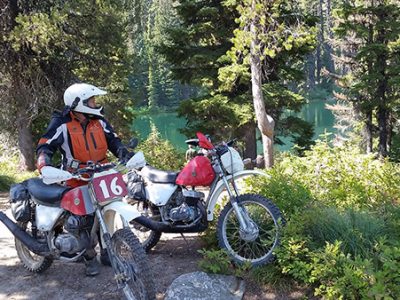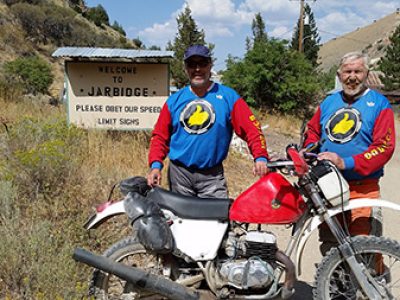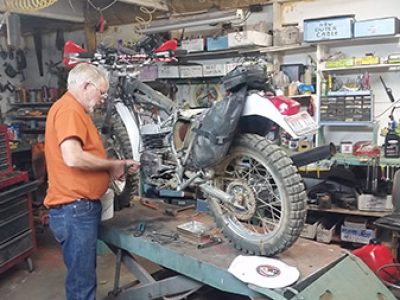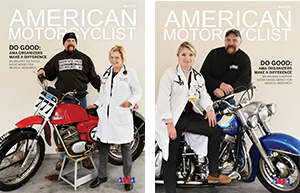AMERICAN MOTORCYCLIST MARCH 2019
Adventure Along the Salmon River
Tackling Idaho On Bultacos
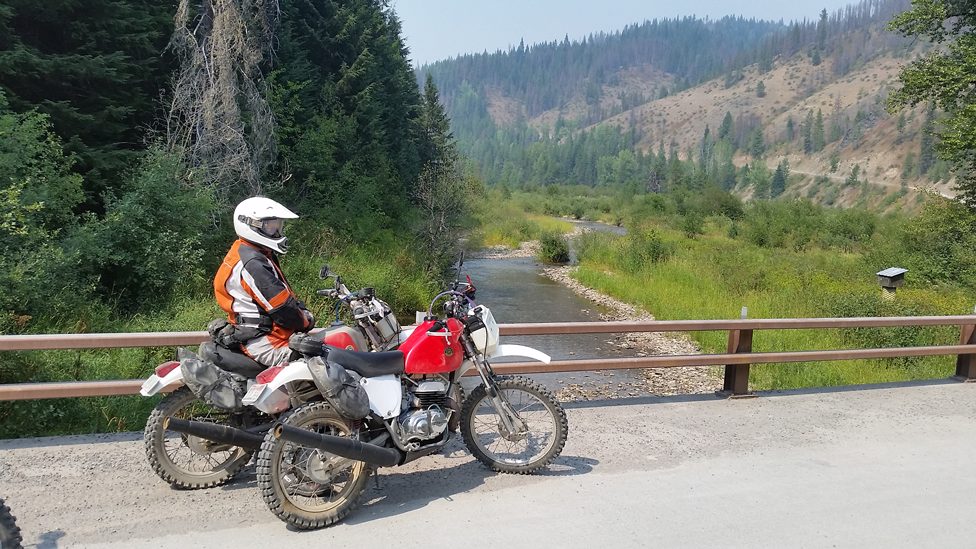
Tepee Creek Near historic Magee Ranger Station. Chilly and Neena at Warm Lake. Gordon and Earle enjoy lunch in Clark Fork.
By Chilly White
Much of life is simply about finding inspiration. As motorcyclists, it seems like an easy enough proposition. Yet, no matter the object of your passion, often, at some point, the passion wanes.
For many years, motorcycle racing was all I lived for. It represented life for me. The same goes for Baja. With both, I have reached a position where there is little new to see and accomplish.
As time passes, the natural desire to slow down grows. There becomes a desire to enjoy more of the scenery, rather than pass through it as quickly as possible.
That was my goal for this ride, which was inspired by a story titled “Two Yankees in Alaska” that I found in a 45-year-old motorcycle magazine.
Prepping for the IBDR
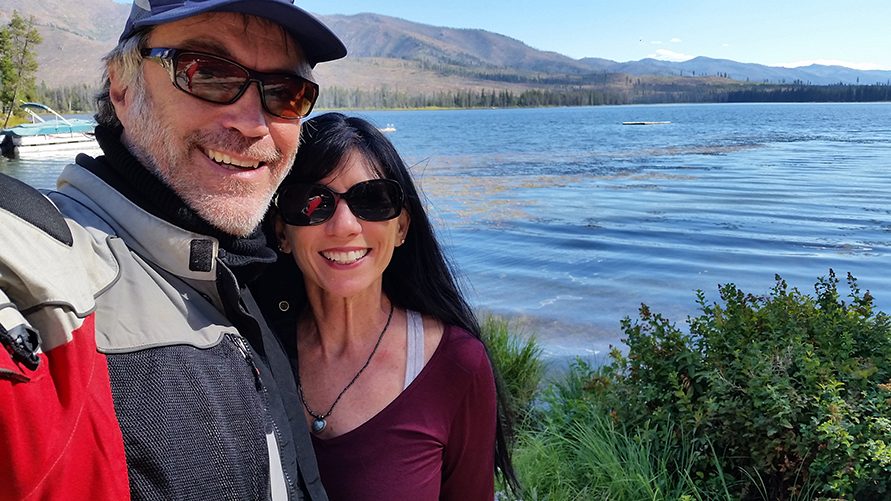
The Idaho Backcountry Discovery Route is the perfect expression of my inspiration. This asphalt-avoiding route covers much of Idaho that I had never seen. It includes 1,250 miles of beautiful scenery, nearly all on dirt. It is a route perfectly suited for adventure bikes.
I would include another key ingredient from the Alaska story—old motorcycles! That is what I would do: Ride vintage bikes on the IBDR.
Of course my dad, Gordon White, would want to come along. At 82, he still rides and races regularly. I am the third generation of our motorcycling family. My grandfather got his first bike in 1921 and went on to become a Harley-Davidson dealer in the Pacific Northwest.
Gordon has a nicely restored 1975 Bultaco Frontera. It wouldn’t take him very much preparation to be ready to go. When I pitched the idea to him, he was ecstatic about the concept.
The logical thing for me to do was to find a Bultaco for myself. As a teenager, I had ridden Bultacos quite a bit, so it wouldn’t be completely new to me.
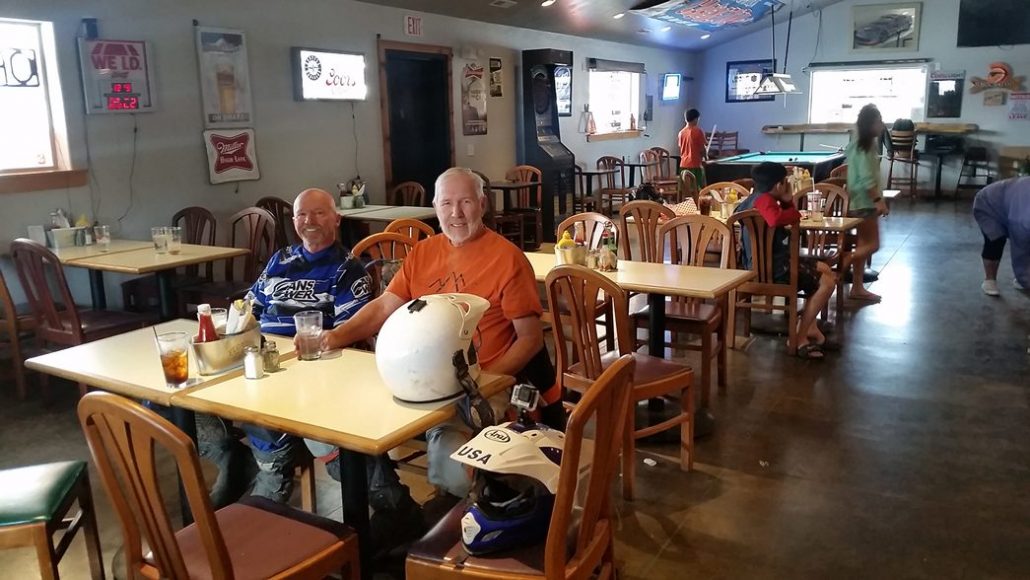
It took only a couple calls before I was the proud owner of my own 360 Bultaco Frontera. It was cosmetically beautiful, but first impressions were deceiving. The bike needed a complete overhaul.
Bruce Reynolds of BR Bultaco built a fine motor and helped me through the rebuilding process with parts and his vast knowledge. After a few months of preparation, I was ready to go.
When I packed for the trip north to Sandpoint, Idaho, Gordon and I made a test run around the roads of Bonner County on our matching Bultacos. Even with the highest possible gearing, the Frontera cruise speed is only about 47 mph. But other than that, all seemed good. On some short sections of fire roads and single track, the 360 proved to be a torque monster and very fun to ride.
These bikes need quality fuel to run well. Fortunately, non-ethanol premium is widely available in Idaho. Even so, my bike was happier when running with an octane additive, Chevron Techtron at 1 ounce per gallon. This was mixed with Maxima Super M at 50:1.
For the IBDR, a 120-mile fuel range is the minimum required. It seems easy enough when looking at distances on the map. But, when you realize you have gone 10 miles down the wrong road and will now need 140 miles of range to make it to the pump, it’s a different thing.
We decided to run the Acerbis 5-liter fork-mount auxiliary tank. They were simple to mount and worked brilliantly. We averaged about 36 mpg on both bikes, which was better than expected.
Getting On The Road
It doesn’t take much for a simple plan to become complex. Once all together, our cavalcade consisted of five people, four motorcycles and one chase truck.
Earl Norman joined us, riding a KTM 525. Neena and Carlene White piloted the chase truck, with gear and a spare bike. Arriving early to each overnight stop, they could plan lodging and meals.
We left Sandpoint the first morning to drive up to Porthill, Idaho, on the Canadian line to start our ride south. In proper vintage bike fashion, Gordon’s bike was reluctant to start without the help of a tow rope. But, once going, it ran great. My bike was still somewhat new to me. I was somewhat tense the first day, getting used to everything.
The Northern Idaho section is easy riding. Our destination for the night was the historic mining town of Wallace. After lunch in Clark Fork, we started on the 100-mile section south.
There were months of preparation on everyone’s part to get to this point, and now it was all happening. We were 50 miles into the section and making good time. We would be into Wallace well before dark to finish up our first ride day.
We stopped to take a few photos along Tepee Creek and the historic Magee Ranger Station. My bike was running fine. Then it wasn’t. It just died. No hesitation, no warning. It kicked back to life briefly and then nothing.
We tried towing it. Nothing. We wrenched on everything we could. Finally, we decided it was the points. But there was nothing we could do on the trail. That left us with nothing but to ride out and try to drive back to retrieve the bike. Gordon volunteered to stay behind, while Earl and I started out. It was early in the afternoon. The weather was fine, so it should all work out OK.
As we rode toward Wallace, it became apparent that this route wouldn’t be suitable for the pickup. There were lots of roads in the area, so there was certainly a better choice.
Arriving in Wallace, we met with the chase truck and got the hotel arranged. Neena and I started back about 5 p.m.
The ride back out to pick up Gordon didn’t go well. We got two flats on the chase truck and had to retreat. Thankfully, Gordon was rescued by a stranger. Even better, he had just enough cell service to call off our rescue attempt, and he rode back into town with his new friend.
It was an exhausting day for me and I was happy to get bed.
Bike Rescue
The next morning, the first stop was Les Schwab for tires for the pickup. While we waited, Gordon called back to Sandpoint to make an appointment with Frank Thieme at Cycle Haus. Frank is an old Bultaco dealer and possesses a wealth of the kind of mechanical knowledge that will soon fade from existence.
The problem was easy to diagnose: burned up points. This was probably due to a bad condenser, a common problem on these bikes. The fix was to relocate the condenser from the motor to the frame, away from the heat. We got the Frontera back together with the relocated new condenser. It was another long day, but a productive one.
Back on the Route
The next morning, we hit it in earnest. My bike ran great. Our route took us along the North Fork of the St. Joe River to Avery.
In the afternoon, I got so caught up in the riding that I missed a turn, and we ended up taking a long route toward Clarkia before getting pointed back in the correct direction.
Late in the day, it became clear that we were not making a very fast pace. Even riding solid, we couldn’t average more than about 20 mph for the trip. Few of the roads were open enough to go much faster, regardless of the bike.
That evening we rolled into Pierce. We found food and lodging without issue, and it was a pleasant stop. Like much of Idaho, it was once a mining boom town and later the center of logging. These days those occupations are gone, and towns like this survive on hunters, tourists and retirees.
The following day took us along the Lolo Motorway, which follows the traditional Nez Perce route east toward the hunting grounds of the Great Plains. This was certainly one of the highlights of the trip, another great day of riding.
Late in the day, Gordon’s Bultaco rolled to a halt. With a new plug, it fired up, and we headed off again. But the fix only lasted a short time. Seems the bike would run when cool and die once warm. We suspected a bad coil.
Consulting the map, I could see we were at a junction that shortened the distance to the highway. Gordon was able to coast miles down to the pavement, and then the bike ran fine the 10 miles up to Lochsa Lodge. We met up with the chase truck and had a fine lunch at a beautiful spot.
We had a long pavement liaison to get over Lolo pass. We loaded up the Bultacos, while Earl had to ride the KTM.
Hamilton, Mont., isn’t overflowing with rooms in the summer. But, as luck would have it, we ended up at an out-of-the-way place called Trapper Creek Lodge.
Magruder Corridor
The next day was a highlight of the trip, the Magruder Corridor.
This would be the longest mileage day and the most remote. This route winds from Montana west to Elk City, Idaho, snaking through the Frank Church River of No Return Wilderness Area.
The historic Magruder Ranger Station was the first stop. Marguder was a packer who was murdered by his crew while returning to Lewiston from selling goods in the Montana mining camps.
It is a beautiful area, and the road was in good condition. As the only access through the wilderness, it is a well-traveled route. We encountered light traffic all day long. We also had to keep an eye out for oncoming side-by-side traffic.
The weather became more menacing. As we rolled into Elk City, the store just closed its doors. Fortunately, the shopkeeper opened back up to let us pump gas.
We still had 60 miles or so to make it to Grangeville for the night when the rain started. The route down the east fork of the Clearwater was pretty, but the rain muted our spirits. As we neared town, the rain came down harder. The mountains we had just crossed were getting blanketed by an August snow storm.
Our chase crew already had motel rooms. Soaked to the bone, I was never so glad to see a cheap hotel room. We topped the night off with some comforting Mexican food.
Rain and Scavenging
The next morning the rains continued.
Since Gordon’s bike acted up two days prior, he rode the KTM spare bike. As we were waiting out the rain, we decided to see if we could go in search of a Bultaco coil in Grangeville, Idaho.
The only likely place we saw to start was the local saw repair shop. Turned out the place was formerly a Honda motorcycle dealer and had a generous scrap area out back. In short order, we scavenged parts from a 1980 Honda XR100: coil and condenser in one unit.
It was decided that we would drive south to Riggins to spend the night. Earl had suffered the day before for lack of rain gear. So he set off in search of some, returning with something that would be suitable for an Alaskan fishing boat. Good thing because, once again, he had to ride while the rest of us rode in the chase truck.
The next morning was clear and cool in Riggins. We followed the Salmon River east for a few miles before leaving it to climb toward Burgdorf Hot Springs. Like much of the route, the climb took us up over 6,000 feet for much of the day. We passed both Burgdorf and Warren, each picturesque and neither with any sign of available fuel.
As we descended along the South Fork of the Salmon River into the remote community of the same name, the weather warmed nicely. After Yellow Pine, the rest of the day was a fast cruise to Warm Lake, where we rented lakeside cabins.
Winding Down
Day 7 found us on a fast run due south once again toward Lowman. After fueling, we crossed another mountain pass that took us to the Middle Fork of the Boise River and the area around Idaho City.
We crossed to the South Fork of the Boise then headed for the highest point of the trip, Trinity Mountain Lookout at 9,400 feet. The last section of the road was gated, but closer inspection revealed that the road remained open for motorcycles.
The view of the surrounding mountains and lakes was breathtaking. After taking it in, we backtracked to catch the road to Featherville, our stop for the night.
The next and final day, the terrain changed from mountains to desert. We met up with the chase crew in Glenn’s Ferry, then started our final stage to the finish in Jarbidge, Nev. We covered the barren Idaho desert in short order.
Jarbidge is a small remote community in a large canyon cut from the desert plain.
We had given ourselves a big challenge. Riding 45-year-old motorcycles from Canada to Nevada is not the kind of adventure you do every day. A photo in front of the town sign was the confirmation we accomplished our goal.
Worthwhile Adventure
The Idaho Backcountry Discovery Route was a trip well worth taking. The roads and scenery left everyone wanting more.
I am glad to have done the entire route. Should I go back, I would skip the first and last day routes, allowing more time to explore everything in between.
Chilly White is a multi-time AMA off-road champion and ISDE competitor from Escondido, Calif. He operates a motorcycle tour company in Baja and logs more than.
IBDR Need To Know
Check out www.bdr.com for all the information, including map and GPS tracks. Both were invaluable for the trip. The map is very well done and acts as a complete guide book.
Idaho Topo base map for Garmin was a significant help (www.gpsfiledepot.com).
Idaho atlas: I would photograph each day’s route, so I had very detailed information on my phone.
In general, fuel was available everywhere indicated on the map, but some locations were low-octane only. Never pass up the opportunity for fuel.
Primitive camping was available nearly everywhere.
Don’t hesitate to ask locals about road conditions and closures. Everyone we encountered was quite friendly and happy to help.
Some of the higher passes are not clear of snow until July. July to September would be the ideal season. Even so, be prepared for any conditions. We rode in fresh snow in August.
Give yourself plenty of time. Eight days would be considered the minimum to complete the route at a casual pace.
Be prepared to fall in love with Idaho, too. Speed averages over the course of a day will be around 20 mph.

